Curing Rooms for Concrete Specimen Testing
- September 28th, 2022
- Category: Equipment Guides
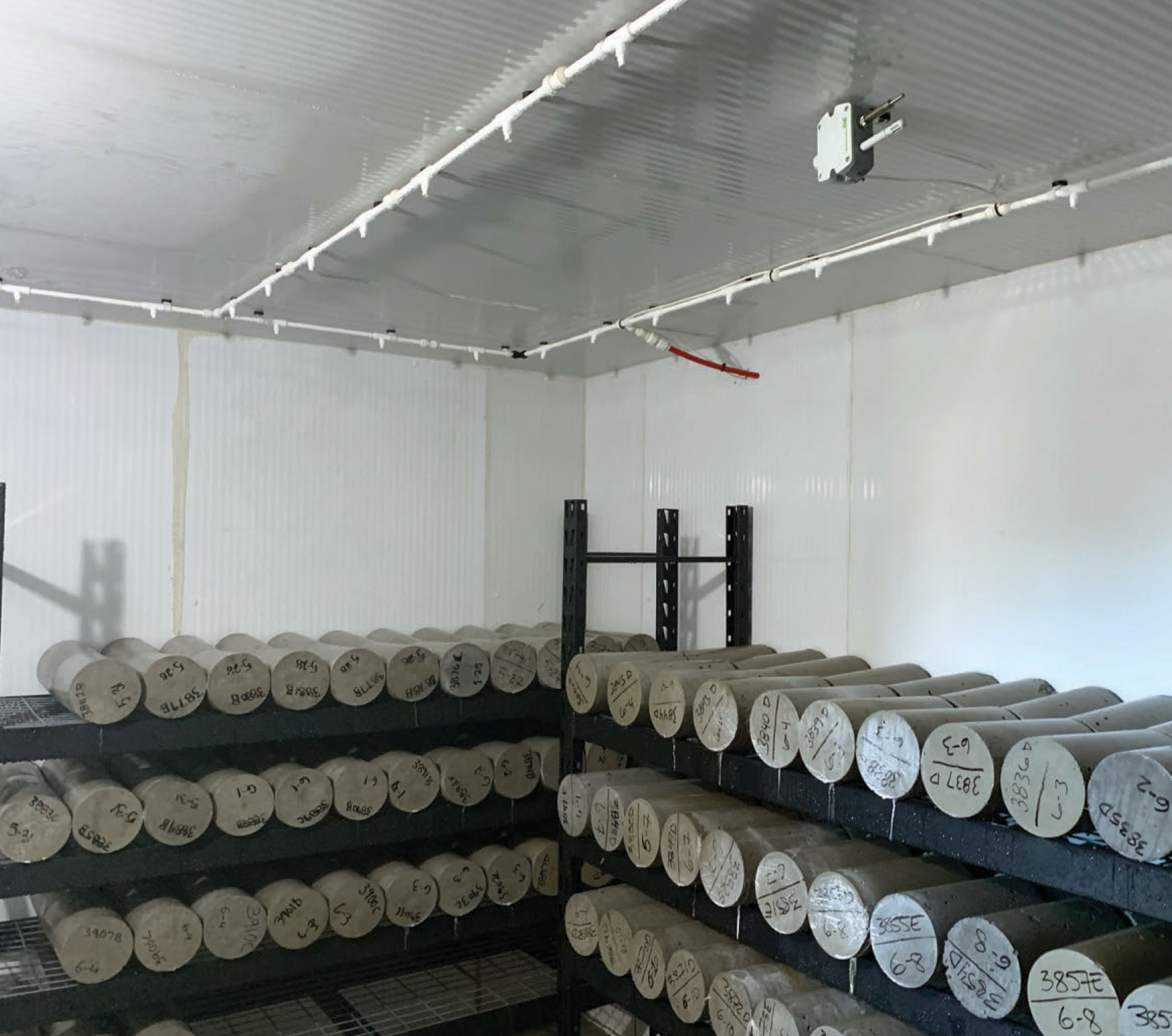
When it comes to testing concrete cylinders and cubes, the proper storage and curing of specimens is just as important as the testing process. Not paying attention to properly curing and storing specimens can lead to erroneous compression test results. Dry conditions, lack of humidity, low and high temperatures can all contribute to inaccurate test results.
For this reason, it is essential to ensure that your curing room is designed to maintain specimens in compliance with ASTM C511 standards. Not maintaining ASTM C511 specifications for your curing and storage practices can also affect other testing standards, such as: ASTM C31, C39, C78, C109. C780, C1077 and E329, rendering them as out of spec. Many CCRL audits report non-compliance problems with curing rooms, curing and storage problems and the records associated with these operations. It is essential that curing and storage be taken seriously and that conditions are accurately documented.
Common errors in this regard include:
- Inability to maintain temperature and humidity levels sufficient for ASTM C511 specifications
- Lack of or insufficient temperature and humidity recording documentation
- Lack of documented weekly temperature and humidity data or semi-annual standardizations
Curing Rooms
While some testing operations can use curing tanks or cabinets for storing test specimens, those labs who plan to do any volume of testing will probably want to build a curing room to accommodate larger numbers of specimens. Also, depending on the specifications or standards you are working with, you may need just a curing room, but in some cases you may need a tank within the curing room as well.
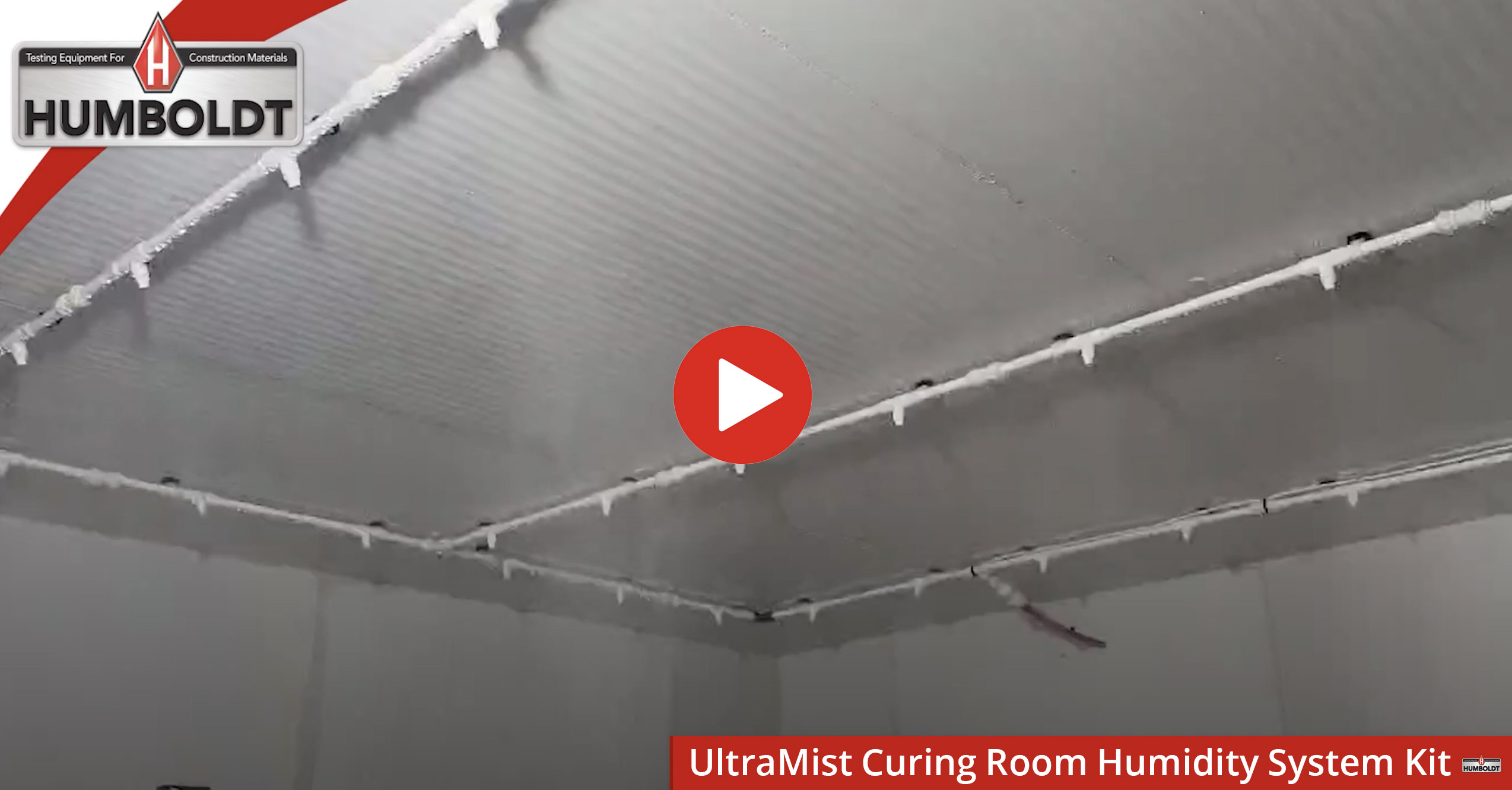
Curing rooms range in size from the size of a closet to much larger rooms. Typical curing rooms are usually constructed of concrete blocks or steel panels with shelving to accommodate specimen storage. Since curing rooms must maintain a humidity greater than 95%, the rooms tend to be wet and full of fog. Most labs tend to construct their own curing rooms since pre-fabricated curing rooms are rare, plus the fact that almost every lab has to deal with their own unique room configurations. The size of your curing room will depend on how many samples you expect to store plus the available space you have to dedicate to the curing room. Some labs use walk-in refrigerators or insulated shipping containers, but most custom build their rooms based on available space. When building your room, care must be taken to ensure airtight seals are established for doors and walls. Construction of the curing room should also include attention to insulation for the room. This helps establish the room's ability to maintain a constant temperature and humidity.
Curing rooms are best placed inside a facility and against an interior wall. If you have to install a curing room against an exterior wall, build in at least 6 inches of dead air space between the walls to insulate between hot or cold outside temperatures, which could impact the curing room conditions.
Most curing rooms use some type of spray mist system to supply and maintain the room at a constant humidity level. When installing a spray mist system, it is advisable to use enough spray nozzles to completely cover the size and configuration of the room. In order to maintain an extremely humid environment, a filtered water supply is needed for your humidifying equipment, and the temperature must be maintained at 21.0 – 25.0˚C (69.8 - 77˚F). In all cases, care should be taken to prevent water from dripping onto specimens, since lime can leach out and lower the specimen strength.
One common problem experienced with curing rooms is that spray nozzles may tend to clog. Without proper maintenance and upkeep, the spray nozzles will begin to drip water on the specimens before clogging entirely. It is highly recommended that you establish and maintain a program in which the spray nozzles are switched out with a second set that has been soaking in a mild acid such as vinegar to slow the clogging process. Maintaining two sets of working spray nozzles tends to be less time consuming than continuously repairing dripping nozzles, or suffering the consequences of improperly cured materials.
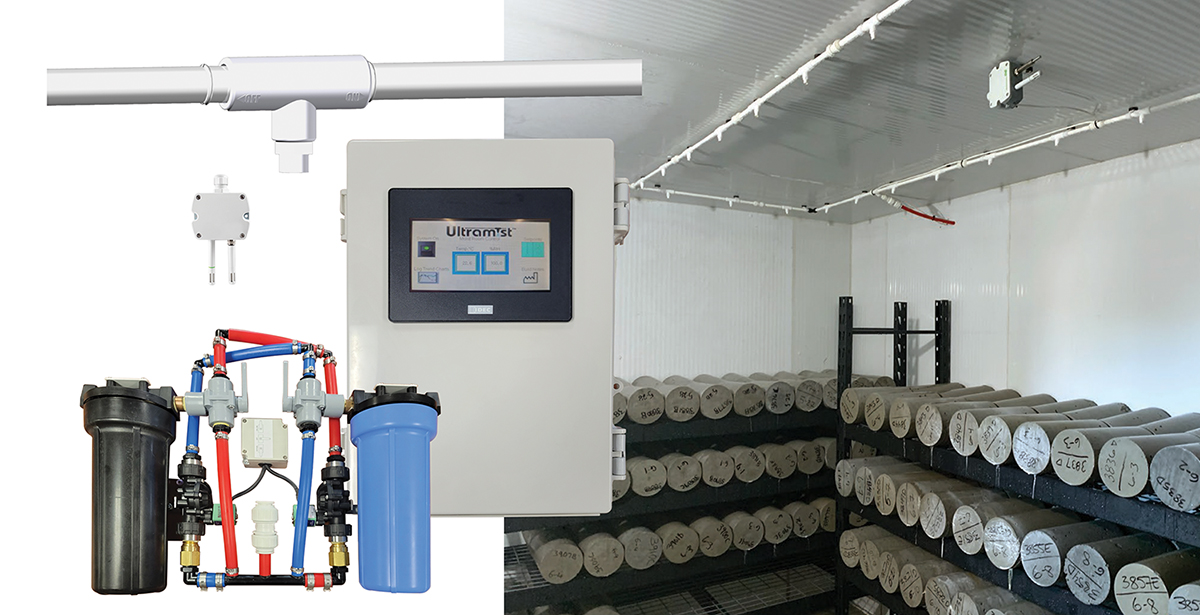
Digital vs Chart Recorder
ASTM C511 requires you to monitor the temperature of your curing room to a 1°C accuracy every 15 minutes and retain this information for reference. This can be accomplished by using either a chart recorder or a digital device. Chart recorders have been the most prevalent method to date, however, digital data loggers are gaining popularity. Having all the data recorded and stored on a computer is certainly an advantage, allowing for easy report generation and reliable archiving of data. However, many still like the visible chart recorders from a familiarity standpoint.
Humboldt Curing Room Systems
Humboldt provides several solutions for equipping concrete curing rooms with temperature, humidity and data logging controls. From the basic VaporPlus Curing Room System, which provides control components for curing rooms to the UltraMist Curing Room Humidity System with its advanced controller and complete mist bar and nozzle assembly for a 10' x 15' room.
The UltraMist Curing Room Kit
The UltraMist Curing Room Kit is designed to provide the ideal solution for maintaining concrete curing rooms within ASTM C511 specifications. The UltraMist Kit maintains curing room temperature at 23°C ±2°C and a relative humidity above 95% on average without the need for HVAC equipment. This is accomplished by the controlled use of hot and cold water misting of the room through the provided mist bar and nozzle assembly, which is designed to cover a 10 x 15 ft. (3 x 4.6m) room. The system is set up to mist the room every hour for 15 seconds, so the specimens remain moist.
The UltraMist Curing Room Kit utilizes air atomization technology to produce a fine vapor fog to create the optimal environment for storing and curing concrete testing samples, such as cylinders. It provides the ideal solution for maintaining the high humidity levels and regulated temperatures required for curing rooms and ASTM C511.
The UltraMist Curing Room System uses the included controller to monitor settings via its LCD touchscreen. The current %RH and temperature are shown on the LCD touchscreen. A trending %RH and temperature chart is also provided. The %RH and temperature readings, which are logged every 5 minutes are stored on a USB flash drive. The controller allows for real‐time temperature and percent relative humidity data logging to be seen on the control panel. In addition, data logging of the temperature and percent relative humidity is recorded on a USB drive in .csv file format.
The basic UltraMist Kit includes the controller, valve/filter assembly board, Sensor and the misting grid for a 10' x 15' room. The kit includes 52 ft. of UltraMist bar with necessary nozzles and fittings. The UltraMist spray bars come in 2 ft. lengths with union connectors for easy push-to-connect assembly. The kit is also available with the TriOBreeze sanitization option, which keeps your curing room’s microbiological load in check. TriOBreeze sanitization injects activated air (e.g., ozone) into the curing room, which cleans and sanitizes the system more effectively and less expensively than a chlorine-based system.
NOTE: The system controls temperature by regulating hot and cold water valves. Your curing room will only get as cold as your cold water and as hot as your hot water.
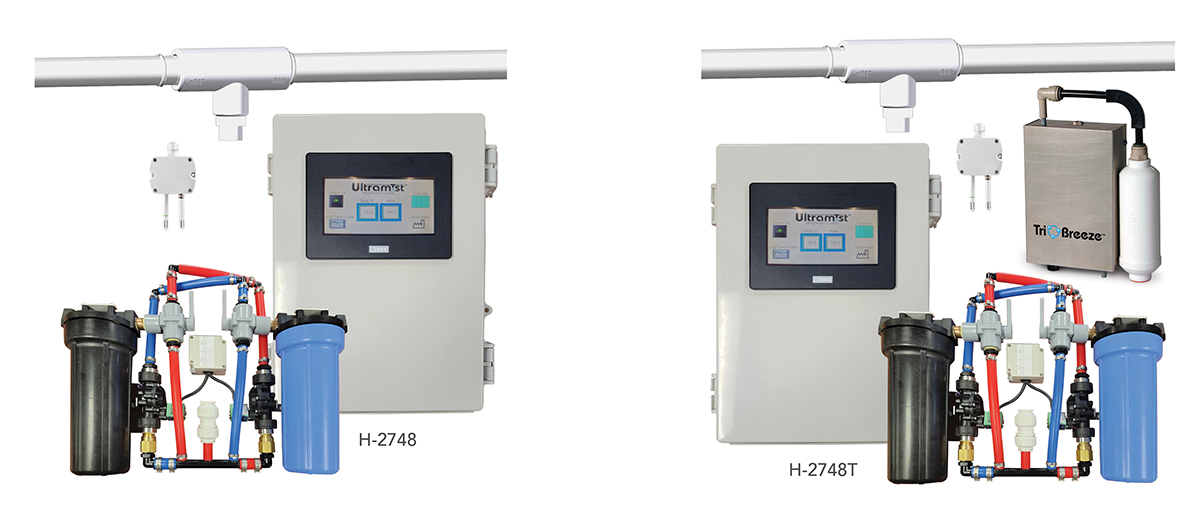
The VaporPlus Curing Room Humidity Systems
The VaporPlus Curing Room System with Touch-Screen Control provides an ideal and easy-to-use solution for maintaining concrete curing rooms within ASTM C511 specifications. The VaporPlus system utilizes air atomization technology to produce a fine vapor fog to create the optimal environment for storing and curing concrete testing samples, such as cylinders. It provides the ideal solution for maintaining the high humidity levels (up to 100%) required for curing rooms and ASTM C511.
The system is comprised of an advanced, touch-screen controller, a water filtration unit, which includes sediment removal and 100% KDF, anti-bacterial filter and a compressor unit, which includes an adjustable water regulator for added humidity control. The system also uses a stainless steel, air atomizing nozzle, which produces a fine vapor fog. This nozzle will not rust and is resistant to clogging.
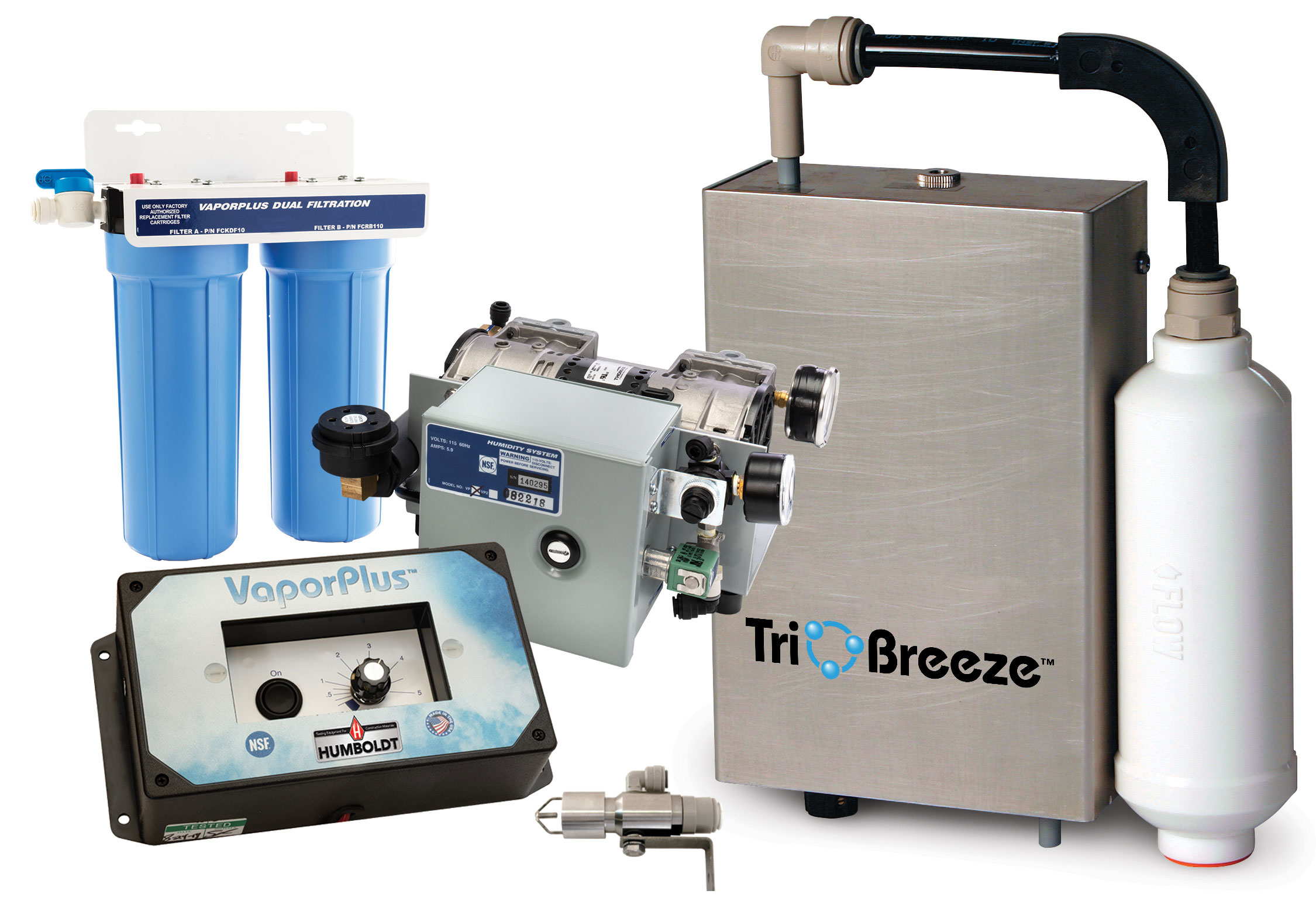
The VaporPlus system is designed to provide consistent humidity results for standard-sized rooms, such as a 12' x 12' x 8', or 1728 cubic feet. However, this single-nozzle system has successfully met ASTM C511 humidity requirements in rooms as large as 5600 cubic ft. Humidity readings can be affected by high ceilings, L-shaped or other room configurations. For these rooms or as rooms get larger, additional nozzles can be added to maintain consistent humidity levels throughout the room. Other factors, which affect humidity levels include nozzle location, as well as the air turnover within the room including times when doors or windows are opened.
VaporPlus Curing Room Systems are now available in several, easy-to-install models allowing you to choose the one that fits your room, budget and needs. Each system comes with a water filtration unit, which includes sediment removal and 100% KDF, anti-bacterial filter and a compressor unit. The systems also includes a stainless steel, air atomizing nozzle, which produces a fine vapor fog. This nozzle will not rust and is resistant to clogging. Tubing is included, which is easily assembled using quick-connect connections.
VaporPlus systems come with either a simple timer control or an advanced, touch-screen, data-logger controller, which records humidity and temperature with the use of the included heated humidity sensor. Models are also available with or without the TriOBreeze Sanitizing System. The TriOBreeze is an effortless way to clean your curing room, without use the of harsh chemicals or manual labor.
Humboldt's VaporPlus™ and UltraMist™ systems for curing rooms provide ideal control of humidity and moisture levels for curing and storing of concrete test samples.
These systems provide testing facilities with these benefits:
- Properly curing and storing of concrete specimens while accommodating curing rooms of all sizes
- Maintaining highly-accurate humidity and moisture settings for ASTM C511 specifications
- Reduce equipment needs and maintenance costs
- Eliminate costly water filtration
- Ability to maintain high relative humidity levels (up to 100%)
- Increase your return on investment
- Ease of installation and very low maintenance
Benefits attained through the use of Humboldt's VaporPlus™ and UltraMist™ systems:
- Nearly unlimited Customizable options
- Flexible configurations/room-sizes are modular and reconfigurable
- Conformity with standards is assured
- Air flow systems are specially engineered to meet the requirement of each individual chamber.
- With ease, our curing rooms can maintain your desired temperature and humidity, they are the ideal place for curing your cement specimens for further testing
- Supplied with LED lights which emit significantly more light per unit of input energy than fluorescent bulbs. They also produce less radiant heat, and with less heat used, the cooling requirement for the controlled
Watch The Video Now!

